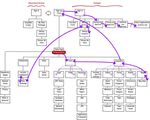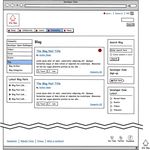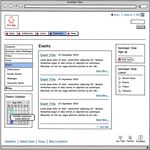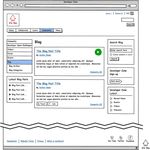SCIVERSE 'DEVELOPER ZONE'
←
→
Page content transcription
If your browser does not render page correctly, please read the page content below
SciVerse ‘Developer Zone’ In response to increasing competition from Google Scholar various sales and marketing initiatives were launched during 2011 to enhance SciVerse’s usability and appeal to its audience. The SciVerse application layer for academic institutions was developed to add specific and relevant functionality in the form of “widgets” which could be used to enhance the search capabilities of users’ individual portals. The goal was to invite members of the software development community to participate in the development of third party applications or widgets for inclusion on the application layer using a business model similar to Apple’s App Store. Invitations were to be made to both for-profit and not- for-profit individuals and organisations but the challenge of how to incentivise developers who were not necessarily motivated by the monetisation of their product. I was given an open brief to develop and visualise a developer community website to promote and encourage participation in the application programme. Certain restrictions were placed around this requirement as it was stipulated that is should be run upon the Drupal content management framework. The challenge was to be innovative and original whilst at the same time using tried and tested methods and technologies. Familiar models of forum based user platforms were used including the relevant content and user management processes. The novelty was to include a simple but effective ranking system (i.e. vote up/vote down) which enabled members of the community to rate their peer’s efforts. This introduced an element of friendly and fun competition between members of the community encouraging participation through the simple psychology of peer pressure and popularity.
SciVerse “Developer Zone” Site Map and Information Architecture
Website Overview
The SciVerse Developer Zone is an online information and workspace
designed to encourage and inform SciVerse application development.
It’s aim is to engage and inform developers and to assist in their progress
towards developing applications.
As well as creating an information space for developers, there is an
opportunity to create interaction between developers and end users in order
to help promote application development in meaningful and relevant ways.
Therefore, the website content has been arranged into 4 main sections:
“Collaborate”, “Learn”, “Community” and “News”.
1. Collaborate.
The “Collaborate” section incorporates the “SciVal Idea Exchange”.
The “SciVal Idea Exchange” is a simple device designed to create real
conversations between end users and developers in order to shape
supply and demand for applications.
2. Learn.
The “Learn” section is the main information space for developers to
access technical documentation and business information.
3. Community.
The “Community” acts as an ‘information hub’, in part providing views,
opinions and feedback from within the developer community in the form
of ‘user generated content’ eg. Blog and Forum, as well as promoting
and reporting relevant activities and events.
4. News.
The “News” section is the publisher’s main broadcast tool for relating
any ongoing information about the website and would be aligned with
any external communications (such as email marketing).
Illustration
To view the site map and sample wireframe mockups of the website, please
view the attached PDF file sv_ia_mockup.pdf
View pages by clicking:
Follow links highlighted by:The SciVerse Developer Zone – User Journey Scenarios
Whilst it is recognized that the Developer user group is clearly divided
between Commercial and Non-commercial (i.e. Academic) developers, the
Information Architecture makes no provision for this differentiation at this
stage.
Rather, it makes provision for the functions required by the two user groups:
1. End Users (i.e. Researchers and Librarians)
2. Developers
Examples:
1. A simplified End User scenario may be:
Home Page/Landing Page > [user may browse site] >Collaborate >
Sign-up > Idea Exchange > Participate
2. A simplified Developer scenario may be:
Home Page/Landing Page > Learn/Community > [user may browse
site] > Sign-up > Collaborate > Idea Exchange > Participate
Illustration
For illustrations of these please view the attached PDF files
sv_ia_user_01.pdf and sv_ia_user_02.pdf
Start at the Homepage:
Link to pages by following:The SciVerse Idea Exchange The perspective of each user group may be visualized simply by the above diagram. Whilst the site is clearly designed for the benefit of Developers and aimed at promoting and informing Application development, the Idea Exchange represents a real opportunity to further and contribute to that development process. These perspectives may also be visualized by overlaying the two sample user journeys already outlined:
Through ongoing engagement within the Idea Exchange and through complimentary marketing, the Developer Zone has the potential to shape, inform and generate Application Development by enabling communication between the two groups, i.e. between supply and demand. The SciVerse Idea Exchange – How it works The SciVal Idea Exchange utilizes a simple, multi-user Blog engine to create a portal where users may suggest an idea for an Application which is then posted in the ‘blog’ or “Activity Dashboard”. Other users may then ‘vote’ ‘for’ or ‘against’ each post, or comment on each post accordingly. The “Activity Dashboard” lists and orders posts by ‘popularity’ depending upon the number of ‘votes’, thus, creating a sense of friendly competition within the Developer community. By gaining popularity and comments from other users developers can test the viability of their ideas and make more informed decisions about them. The opportunity for both user groups to use this platform simultaneously creates an interesting dynamic in their relationship and furthers the opportunity to create new ideas. Further development of the Idea Exchange into a Wiki format where ideas may be discussed in more detail than a commenting system would allow could be discussed further. Conclusion Whilst this Information Architecture identifies key areas of the site and shows how they can be made relevant to users and achieve the goals of encouraging and informing SciVerse application development, it is essentially a prototype. Further experimentation with the Information Architecture may present more complex or alternative scenarios highlighting areas for further development and showing where Calls to Action may require more prominence.
You can also read



























































